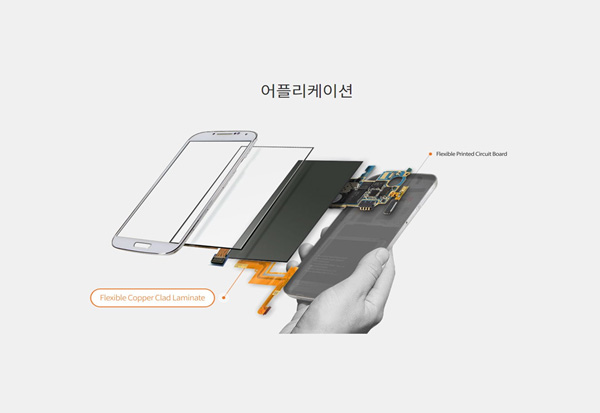Applied Fields
Applied Fields
Electromagnetic shielding films, monitor security films, retro-reflection films, conductive films, half mirrors, non-conductive deposition films, window films for architecture, tinting films for vehicles, etc.

Next generation flexible electrodes and stretchable films
The conventional devices based on glass substrates that use optical plastic films with flexibility have developed into flexible electronics based on flexible substrates like PET, PEN, PI, and PC. We can apply sputtering deposition to such devices and embody thin films that are safe against moisture and oxygen permeation.
Transparent electrodes are functional thin-film electrodes that have a high visible light transmittance of over 88% and conductivity. They can be utilized in diverse fields, such as foldable smartphones, transparent display devices, touchscreens, and next generation flexible solar cells.
Metal electrodes are patterned in the form of nanomesh, having a high light transmittance while maintaining a high conductivity of the metal. This material can replace transparent metal oxide electrodes. In the latest flexible trend, it can be applied to parts that aim for slimming and increased durability of devices.

Electromagnetic shielding films
Parts with different frequency ranges are embedded in electronic devices nowadays. They generate complex electromagnetic noise, which frequently causes data interference errors or data loss.
We insert a primer layer made of polymer resins between the polymer film and the metallic layer in charge of conductivity to increase the adhesion between the material and metallic layer. After forming a tin layer through sputtering deposition, an electromagnetic shielding film with excellent conductivity, electromagnetic shielding, and flexibility is manufactured through plating and electroless nickel plating.

Sputter transparent thermal shielding films
Metal particles are made on the surface of PET films by sputtering vacuum deposition to increase the thermal shielding rate by reflecting visible light and infrared light. These films have beautiful appearance and can easily control the thermal shielding rate.
We make sputtered films for glass used in buildings for the thermal shielding film market. Our core technology involves the production of films with excellent visibility and energy-saving performance. (Thermal absorption, thermal shielding, visible light transmittance/reflection, radio interference, etc.)
Metals like titanium, copper, stainless steel, silver, ITO, and nickel chromium are sputtered on the PET film to reflect visible light and small amount of infrared light. It can be applied to thermal shielding films through postprocessing.

Thin films for solar cells
Flexible thin-film solar cell modules
Film-type rollable solar cell modules can replace the conventional solar cells that are heavy and brittle. Thin films in the modules are embodied by sputtering deposition. The modules can be carried and installed easily
Applied fields: Solar system accessory for camping cars, vehicles, caravans, containers, prefabricated buildings

Retro-reflection films
Use of retro-reflection films
Retro-reflection films are mainly applied to road traffic safety products, such as road and traffic signs, temporary signs, and median strips. Statistics reveal that 90% of traffic accidents can be prevented by attaching a reflective film to pedestrians who are wearing unnoticed clothes at night. Accordingly, retro-reflection films are widely applied to safety products for night work.

NCVM
Non-Conductive Vacuum Metallization
Thin films are made by depositing a non-conductive metal on the plastic base material through sputtering.
This technique is primarily used to improve the appearance or physical performance and protect against electromagnetic interference.
A non-conductive metal deposition layer can be formed by controlling the thickness of the silicone thin-film layer or alloy layer of tin and indium. This technique can create metallic textures without influencing the operation of electronic devices.


